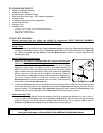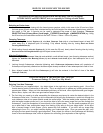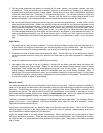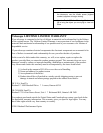
HOW TO USE YOUR NEW TELESCOPE
Astronomical telescopes are designed such that the image you see will appear
UPSIDE DOWN and REVERSED, this is acceptable for viewing celestial bodies.
Selecting an Ocular Lens:
1. You should always start viewing with the lowest power eyepiece, which in this case is the 20 mm lens. Note:
the base power of each ocular lens is determined by the focal length of the telescope objective lens, which for
this model is 700 mm. A formula can be used to determine the power of each eyepiece: Telescope
OBJECTIVE lens (Primary Mirror) focal length EYEPIECE focal length = MAGNIFICATION (e.g. Using
the 20 mm lens, the calculation would look like this: 700 mm ÷ 20mm = 35x or 35 power.)
Focusing Telescope:
1. After selecting the desired Eyepiece (3), aim Main Telescope Tube (14) at a land-based target at least 200
yards away (e.g. A telephone pole or building). Fully extend focusing tube by turning Rack and Pinion
Focusing Mechanism (2).
2. While looking through selected Eyepiece (3) (in this case the 20 mm), slowly retract focusing tube by turning
Rack and Pinion Focusing Mechanism (2) until object comes into focus.
Aligning Finderscope:
1. Look through Main Telescope Tube (14) and establish a well-defined target. (see focusing telescope section)
tighten the Stabilizer Bar Mounting Screw (11) and Azimuth Lock Screw (5) so that telescope’s aim is not
disturbed.
2. Looking through finderscope, alternate tightening each Finderscope Adjustment Screw until crosshairs of
finderscope are precisely centered on the same object already centered in main telescope tube's field of view.
3. Now, objects located first with the Finderscope (1) will also be centered in the field of view of the Main
Telescope Tube (14).
Never Look Directly At The Sun With Your Telescope
Permanent Damage To Your Eyes May Result.
Enjoying Your New Telescope
1. First determine your targeted object. Any bright object in the night sky is a good starting point. One of the
favorite starting points in astronomy is the moon. This is an object sure to please any budding astronomer or
experienced veteran. When you have developed proficiency at this level, other objects become good targets.
Saturn, Mars, Jupiter, and Venus are good second steps to take.
2. The first thing you need to do after assembling the telescope as planned is center the desired object in the
finderscope cross hairs. Provided you did a reasonable job aligning the finderscope, a quick look through the
main telescope tube at low power should reveal the same image. With the lowest power eyepiece (the one
with the largest number printed on it) you should be able to focus the same image that you saw through the
finderscope. Avoid the temptation to move directly to the highest power. The low power eyepiece will give
you a wider field of view, and brighter image--thus making it very easy to find your target object. At this point
with a focused image in both scopes, you've passed the first obstacle. If you don't see an image after
attempting to focus it in, you might consider aligning your finderscope again. Once you pass this step, you'll
will enjoy the time spent ensuring a good alignment. Every object you center in the finderscope will be easily
found in the main telescope tube, which is important for continuing your exploration of the night sky.








